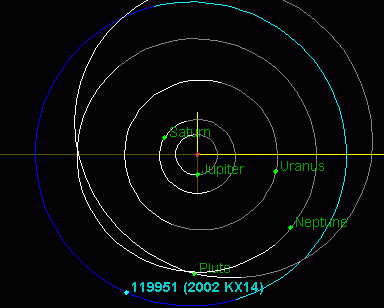Jump to content
Main menu
Navigation
●Main page
●Contents
●Current events
●Random article
●About Wikipedia
●Contact us
●Donate
Contribute
●Help
●Learn to edit
●Community portal
●Recent changes
●Upload file


Search
●Create account
●Log in
●Create account
● Log in
Pages for logged out editors learn more
●Contributions
●Talk
(Top)
1
See also
2
References
3
External links
(119951) 2002 KX14
●العربية
●Чӑвашла
●Deutsch
●Ελληνικά
●Esperanto
●Français
●Gaeilge
●Galego
●Bahasa Indonesia
●Македонски
●مصرى
●Minangkabau
●Português
●Русский
●中文
Edit links
●Article
●Talk
●Read
●Edit
●View history
Tools
Actions
●Read
●Edit
●View history
General
●What links here
●Related changes
●Upload file
●Special pages
●Permanent link
●Page information
●Cite this page
●Get shortened URL
●Download QR code
●Wikidata item
Print/export
●Download as PDF
●Printable version
In other projects
●Wikimedia Commons
Appearance
From Wikipedia, the free encyclopedia
(119951) 2002 KX14 (provisional designation 2002 KX14) is a medium-sized trans-Neptunian object (TNO) residing within the Kuiper belt. It was discovered on 17 May 2002 by Michael E. Brown and Chad Trujillo.[1]
It has a semi-major axis, orbital period and orbital eccentricity close to that of a plutino.[10] The orbital periods of plutinos cluster around 247.2 years (1.5 times Neptune's orbital period), close to 2002 KX14's orbital period. However, 2002 KX14 is not a plutino, as it is not actually in a resonance with Neptune, and it may have formed near its present nearly circular orbit lying almost perfectly on the ecliptic. This TNO may have remained dynamically cold since its formation, and thus its orbit may not have been a direct result of significant perturbations from Neptune during its migration to the outer solar system. The Deep Ecliptic Survey (DES) currently classifies it as a cubewano (classical) based on a 10-million-year integration of the orbit.[2]

2002 KX14 comes to opposition in late May at an apparent magnitude of 20.4.[8][9] This makes it about 360 times fainter than Pluto.[11]
 The evolution of the semi-major axis of both Pluto (pink) and (119951) 2002 KX14 (blue).
The evolution of the semi-major axis of both Pluto (pink) and (119951) 2002 KX14 (blue).
See also[edit]
References[edit]
^ JPL Horizons Observer Location: @sun (Perihelion occurs when deldot changes from negative to positive. Uncertainty in time of perihelion is 3-sigma.)
^ "(119951) 2002 KX14 2020 May 26". euraster.net. Euraster. 26 May 2020. Retrieved 19 September 2020.
^ Kretlow, Mike; Sicardy, Bruno; Santos-Sanz, Pablo; Ortiz, Jose L.; Desmars, Josselin; Morales, Nicolás; et al. (September 2021). The May 26, 2020 multi-chord stellar occultation by the trans-Neptunian object (119951) 2002 KX14 (PDF). 15th Europlanet Science Congress 2021. Europlanet Society. Bibcode:2021EPSC...15..520K. doi:10.5194/epsc2021-520. EPSC2021-520. Retrieved 26 June 2022.
^ a b c Alvarez-Candal, A.; Ortiz, J. L.; Morales, N.; Jiménez-Teja, Y.; Duffard, R.; Sicardy, B.; et al. (November 2014). "Stellar occultation by (119951) 2002 KX14 on April 26, 2012". Astronomy & Astrophysics. 571 (A48): 8. Bibcode:2014A&A...571A..48A. doi:10.1051/0004-6361/201424648. Archived from the original on 10 March 2016.
^ a b c
Vilenius, E.; Kiss, C.; Mommert, M.; et al. (2012). ""TNOs are Cool": A survey of the trans-Neptunian region VI. Herschel/PACS observations and thermal modeling of 19 classical Kuiper belt objects". Astronomy & Astrophysics. 541: A94. arXiv:1204.0697. Bibcode:2012A&A...541A..94V. doi:10.1051/0004-6361/201118743. S2CID 54222700.
^ a b "(119951) = 2002 KX14". minorplanetcenter.net. IAU Minor Planet Center. Retrieved 28 November 2022.
^ a b "HORIZONS Web-Interface". JPL Solar System Dynamics. Retrieved 20 July 2008.
^ John S. Lewis (2004). "Plutinos 2nd paragraph". Physics and Chemistry of the Solar System. Academic Press. p. 410. ISBN 978-0-12-446744-6.
^ (5th root of 100)^(20.4-14=363)
External links[edit]
|
t
e
|
|---|
|
| Consensus |
|


|
|---|
| Possible |
|
|---|
|
Retrieved from "https://en.wikipedia.org/w/index.php?title=(119951)_2002_KX14&oldid=1196887883"
Categories:
●Minor planet object articles (numbered)
●Classical Kuiper belt objects
●Discoveries by Michael E. Brown
●Discoveries by Chad Trujillo
●Possible dwarf planets
●Astronomical objects discovered in 2002
●Objects observed by stellar occultation
Hidden categories:
●Use dmy dates from June 2023
●JPL Small-Body Database ID different from Wikidata
●Articles with JPL SBDB identifiers
●Articles with MPC identifiers
●This page was last edited on 18 January 2024, at 20:04 (UTC).
●Text is available under the Creative Commons Attribution-ShareAlike License 4.0;
additional terms may apply. By using this site, you agree to the Terms of Use and Privacy Policy. Wikipedia® is a registered trademark of the Wikimedia Foundation, Inc., a non-profit organization.
●Privacy policy
●About Wikipedia
●Disclaimers
●Contact Wikipedia
●Code of Conduct
●Developers
●Statistics
●Cookie statement
●Mobile view





